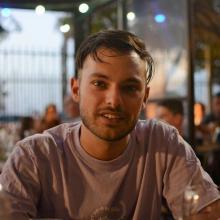Evolution, Behaviour, Adaptation Group
Members

Maîtresse de conférences
UCBL
Tel: 33 04 72 43 26 33

Assistant ingénieur CDD
CNRS
Tel: 04 72 44 81 42
Doctorante
CNRS

Professeure des universités
VetAgro-Sup
Tel: 04 78 87 25 71
Maîtresse de conférences
UCBL
Tel: 04 72 44 80 67

Professeur des universités
UCBL
Tel: 33 04 72 43 26 33

Directrice de recherche
CNRS
Tel: 33 04 72 43 14 04

Chargée de recherche
CNRS
Tel: 04 72 44 81 42

Maître de conférences
UCBL
Tel: 33 04 72 43 13 37

Maîtresse de conférences
UCBL
Tel: 04 72 43 12 86

Directrice de recherche
CNRS
Tel: 33 04 72 43 29 10

Doctorant
UCBL
Tel: 04 72 44 81 42
Doctorante
UCBL

Professeur des universités
UCBL
Tel: 33 04 72 43 29 03
Directeur de recherche
CNRS
Tel: 04 72 44 81 42

Maître de conférences
UCBL
Tel: 33 04 72 43 27 85

Post-doc
UCBL
The Evolution, Adaptation and Behavior group aims at studying the evolution of phenotypic and behavioral traits through a combination of long-term monitoring of natural populations, of field and lab experiments, of molecular analyses, and of mathematical and computational modeling. Our research mainly focuses on animals, in particular mammals (alpine marmot, giraffe), birds (white-throated dipper, collared flycatcher, great tit) and insects (various Drosophila species, the parasitoid wasp Venturia canescens).
We study the evolution of fitness-related traits in interaction, either selective or plastic, with an individual’s biotic and abiotic environment. Interactions between individuals have a special importance in our reasoning and are thus the object of a first axis of research on group dynamics and social interactions. We also consider the environment as providing resources and informative signals through two other axes, one on phenotypic plasticity and the other on resource allocation and the sensitivity to environmental variables. In both, we consider the impact of stress factors caused by human activities — such as global warming, artificial lighting or invading species — or by the presence of pathogens.
Group dynamics and social interaction. The environment encountered by numerous animals contains, on top of resources and other elements, other individuals. Social interactions vary immensely between species, from a solitary lifestyle to such an extreme degree of cooperation that a part of the group sacrifices their reproduction at the benefit of others, specialized in this task. In this axis, we try to understand how groups form and how social structures are maintained, at various scales extending from unicellular organisms to cooperative mammals.
Here are a few examples of questions that we address:
- Evolution of sociality: what are the consequences of climate change on the benefits of group living (in the alpine marmot)? How does that impact group composition and the probability and age of dispersal?
- Group dynamics: how does the size and composition of familial groups evolve in the context of climate change? In giraffes, how do temporary groups form, and what role do kinship play in the probability and duration of pairing?
- Which evolutionary trajectories have led to multicellular organisms expressing differentiated cell types, a part of which sacrifice their reproduction?
- What are the neurogenomic determinants that signal the presence of related individuals in solitary individuals, triggering altruistic behaviors?
Phenotypic plasticity. Evolution by natural selection can drive phenotype changes on short timescales, in the order of a few generations. Yet it remains inefficient to track more frequent environmental changes. Phenotypic plasticity is a means to buffer such environmental variations, either through informed decisions or fixed reaction norms, which are the object of study in this axis.
Here are a few examples of questions that we address:
- How do individual characteristics, in particular personality traits, shape the use of information on the environment for decision-making?
- Is there a trade-off between the speed of decision making and its accuracy? What conditions favor genotypes that make fast, error-prone decisions, or slower, more accurate genotypes?
- What types of environmental variations select for plastic genotypes?
- Do changes in gene expression observed during environmental fluctuations induce behavioral changes?
Resource allocation and sensitivity to environmental variables. Organisms make other decisions throughout their lives as they decide how much resources to allocate to various traits, such as survival, growth, reproduction or immunity. This differential allocation of resources relies on complex systems, or instance the endocrine system in animals, that we study. These systems can be disturbed by anthropogenic changes that disrupt the long-term ecological setting in which they have evolves, resulting in major phenotype perturbations.
Here are a few examples of questions that we address:
- How do endocrine systems — that allow the communication between tissues and control the differential allocation of resources — evolve?
- How do chemical pollutants affect physiological processes, ageing and thereby life-history strategies in response to environmental variation?
- What role do climatic fluctuations play in the heterogeneity of parasite infection, especially at stages that go through the external environment?
Publications
Display of 151 to 180 publications on 455 in total
Vocal behaviour of mates at the nest in the White-throated Dipper Cinclus cinclus: contexts and structure of vocal interactions, pair-specific acoustic signature
Wilson journal of ornithology . 158 ( 4 ) : 897 - 910
Journal article
see the publicationAssessment of individual and conspecific reproductive success as determinants of breeding dispersal of female tree swallows: a capture-recapture approach
Ecology and Evolution . 7 ( 18 ) : 7334-7346
DOI: 10.1002/ece3.3241
Journal article
see the publicationThe relationship between plumage colouration, problem-solving and learning performance in great tits Parus major
Journal of Avian Biology . 48 : 1246-1253
DOI: 10.1111/jav.00953
Journal article
see the publicationIntegrative genomics and gene networks for studying phenotypic plasticity in the pea aphid
10th Arthropod Genomics Symposium .
Conference paper
see the publicationApproches expérimentales de l’étude de la Plasticité Phénotypique
Ecole thématique PLASPHEN .
Conference paper
see the publicationThe ecology of fly-bacteria-yeast symbiosis: no relevance of laboratory interactions to in-natura processes
Colloque Immunité des Invertébrés (Immuninv 2017) .
Conference paper
see the publicationThe ecology of fly-bacteria-yeast symbiosis: laboratory interactions and their relevance to in-natura processes
Réunion REID .
Conference paper
see the publicationInvasive Drosophila suzukii facilitates Drosophila melanogaster infestation and sour rot outbreaks in the vineyards
Royal Society Open Science . 4 ( 3 ) : np
DOI: 10.1098/rsos.170117
Journal article
see the publicationChapter eight - How host plant and fluctuating environments affect insect reproductive strategies?
Insect-Plant Interactions in a Crop Protection Perspective . 81 ( 1.ed. ) : 259-287
Book chapter
see the publicationWhere and what to feed? Differential effects on fecundity and longevity in the invasive Drosophila suzukii
Basic and Applied Ecology . 19 : 56-66
Journal article
see the publicationImpact of Wolbachia on oxidative stress sensitivity in the parasitic wasp Asobara japonica
PLoS ONE . 5 : 10
Journal article
see the publicationAcoustic communication between mates in White-Throated Dippers, Cinclus cinclus
46ème COLLOQUE de la Société Française pour l’Etude du Comportement Animal SFECA 2016 .
Conference paper
see the publicationMaternal condition and previous reproduction interact to affect offspring sex in a wild mammal
Biology Letters . 12 ( 8 ) : 20160510
Journal article
see the publicationPaternal reproductive success drives sex allocation in a wild mammal
Evolution international journal of organic evolution . 70 ( 2 ) : 358-368
DOI: 10.1111/evo.12860
Journal article
see the publicationN. A. C. conduite à tenir face à une diarrhée chronique chez le furet
Le Nouveau Praticien Vétérinaire. Elevages et Santé . 14 ( 63 ) : 62-68
Journal article
see the publicationArrhenotokous parthenogenesis and mate-finding Allee effect in parasitoids
SFécologie .
Conference paper
see the publicationDiploid male production correlates with genetic diversity in the parasitoid wasp Venturia canescens : a genetic approach with new microsatellite markers
Ecology and Evolution . 6 ( 18 ) : 6721 - 6734
DOI: 10.1002/ece3.2370
Journal article
see the publicationHaematophagy is costly: respiratory patterns and metabolism during feeding in Rhodnius prolixus
Journal of Experimental Biology . 219 ( 12 ) : 1820-1826
DOI: 10.1242/jeb.120816
Journal article
see the publicationAn R package for analyzing survival using continuous-time open capture-recapture models
Methods in Ecology and Evolution . 7 : 518-528
Journal article
see the publicationNetwork Analysis Shows Asymmetrical Flows within a Bird Metapopulation
PLoS ONE . 11 ( 11 ) : e0166701
Journal article
see the publicationLow but contrasting neutral genetic differentiation shaped by winter temperature in European great tits
Biological Journal of the Linnean Society . 118 ( 3 ) : 668-685
DOI: 10.1111/bij.12745
Journal article
see the publicationEffect of an anti-malaria drug on behavioural performance on a problem-solving task: An experiment in wild great tits
Behavioural Processes . 133 : 24-30
Journal article
see the publicationMate choice for neutral and MHC genetic characteristics in Alpine marmots: different targets in different contexts?
Ecology and Evolution . 6 ( 13 ) : 4243-4257
Journal article
see the publicationA nonlethal sampling method to obtain, generate and assemble whole blood transcriptomes from small, wild mammals
Molecular Ecology Resources . 16 ( 1 ) : 150 - 162
Journal article
see the publicationTrophic interactions may reverse the demographic consequences of inbreeding
Ecology . 97 ( 11 ) : 3131 - 3142
DOI: 10.1002/ecy.1544
Journal article
see the publicationEffects of daily fluctuating temperatures on the Drosophila–Leptopilina boulardi parasitoid association
Journal of Thermal Biology . 60 : 95 - 102
Journal article
see the publicationInteractive vocal communication at the nest by parent Great Tits Parus major
Ibis . 158 ( 3 ) : 630-644
DOI: 10.1111/ibi.12374
Journal article
see the publicationAll or nothing: Survival, reproduction and oxidative balance in Spotted Wing Drosophila (Drosophila suzukii) in response to cold
Journal of Insect Physiology . 89 : 28-36
Journal article
see the publicationInfluence of oxidative homeostasis on bacterial density and cost of infection in Drosophila–Wolbachia symbioses
Journal of Evolutionary Biology . 29 : 1211-1222
DOI: 10.1111/jeb.12863
Journal article
see the publicationInvasion speeds of Triatoma dimidiata, vector of Chagas disease: An application of orthogonal polynomials method
Journal of Theoretical Biology . 395 : p. 126–143
Journal article
see the publication
You also, comment on this article